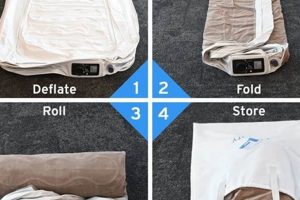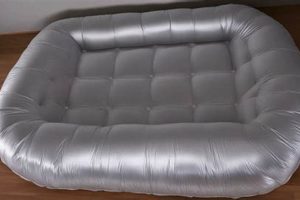Repairing inflatable beds focuses on pinpointing and sealing punctures or separations in the material. Identifying the source of escaping air is the initial critical step, followed by the application of an appropriate sealant or patch designed for the specific material of the mattress. This process aims to restore the air retention capability of the bed.
Maintaining the integrity of such beds offers several advantages, including prolonging the lifespan of the product, avoiding the cost of replacement, and ensuring consistent comfort for the user. Historically, methods for addressing these issues have evolved from simple adhesives to specialized repair kits and techniques developed alongside advancements in materials science and manufacturing processes.
The subsequent sections will detail common methods for locating punctures, selecting the appropriate repair materials, and executing effective sealing techniques to restore the functionality of an inflatable sleeping surface.
Tips for Addressing Inflatable Bed Depletion
The following outlines actionable steps for effectively managing and rectifying loss of inflation in air mattresses.
Tip 1: Listen Carefully. Prior to visual inspection, carefully listen for hissing sounds. This can aid in quickly pinpointing the area of air escaping, especially in quiet environments.
Tip 2: Employ Soapy Water. A mixture of mild dish soap and water, applied with a sponge or spray bottle, will create bubbles at the site of a minuscule puncture. Observe carefully for even slight bubbling.
Tip 3: Utilize a Bright Light Source. Directing a strong light at the mattress surface can reveal subtle distortions or imperfections in the material, potentially indicating the location of a breach.
Tip 4: Submerge in Water (Smaller Mattresses). For smaller, manageable mattresses, complete submersion in a tub or pool can readily expose leakage points via escaping air bubbles. Dry thoroughly after inspection.
Tip 5: Apply Appropriate Patch Material. Select a patch specifically designed for the mattress material. Vinyl patches are generally suitable for vinyl mattresses, while specialized fabrics may be required for other materials. Ensure the patch is adequately sized to cover the damaged area with overlap.
Tip 6: Prepare the Surface Thoroughly. Clean the area surrounding the puncture with isopropyl alcohol to remove dirt and oils. Allow the area to dry completely before applying any adhesive or patch.
Tip 7: Apply Pressure During Curing. After applying the patch, maintain consistent pressure on the repaired area for the recommended curing time, typically several hours, to ensure a secure bond.
Tip 8: Re-inflate and Monitor. Following the curing period, fully re-inflate the mattress and monitor for any further pressure loss. If leakage persists, re-evaluate the repair or consider alternative solutions.
These tips provide practical guidance for effective inflatable bed maintenance. Adherence to these guidelines can significantly extend the usable lifespan of the mattress and maintain optimal performance.
The subsequent section will explore advanced repair techniques and when professional assistance might be required.
1. Locate the Leak
The process of “how to fix air mattress leak” fundamentally hinges on accurately pinpointing the source of the depletion. The ability to locate the leak directly influences the effectiveness and longevity of any subsequent repair attempts. Failure to accurately identify the leak negates the possibility of applying a targeted solution, rendering any efforts to seal the breach ineffective. For instance, applying a patch to an area adjacent to the actual puncture will not prevent further air loss.
Several methods exist for leak detection, ranging from auditory assessments listening for escaping air to visual inspections using soapy water to identify bubbles forming at the breach point. Larger punctures may be readily apparent, while smaller, more insidious leaks necessitate employing systematic techniques. The effectiveness of these methods depends on factors such as the ambient noise level, the size of the mattress, and the magnitude of the leak itself. The correct methods ensure that the leaking areas must be clearly found out, as well as taking pictures, record it as evidence.
In summary, successful repair of inflatable beds begins with effective leak localization. Without this crucial step, efforts to seal the puncture are likely to fail, leading to continued deflation and ultimately, the need for replacement. The time invested in thorough leak detection represents a critical component of the overall repair process and directly impacts the long-term usability of the mattress. Accurate leak locations determine successful patching.
2. Surface Preparation
Effective inflatable bed repair necessitates meticulous surface preparation. The integrity of the bond between the mattress material and the repair patch is directly proportional to the cleanliness and condition of the surface. This preliminary step cannot be overlooked, as it directly impacts the long-term success of the repair, the whole process is “how to fix air mattress leak”.
- Cleaning the Area
Contaminants such as dirt, oils, and residues impede proper adhesion. Cleaning the area surrounding the puncture with isopropyl alcohol removes these substances, creating a suitable bonding surface. Failure to adequately clean the area results in a compromised bond, potentially leading to premature patch failure and renewed air leakage. Improper cleaning causes patching failures.
- Drying the Surface
Moisture between the mattress material and the patch inhibits the adhesive’s ability to create a strong bond. Allowing the cleaned surface to air dry completely ensures optimal adhesion. Rushing this step can trap moisture, leading to a weak bond and eventual patch separation. Complete drying for leak prevention.
- Sanding (if applicable)
Certain inflatable bed materials, particularly those with a smooth or glossy finish, benefit from light abrasion to create a textured surface for better adhesive grip. Lightly sanding the area with fine-grit sandpaper roughens the surface, enhancing the mechanical bond between the patch and the mattress. This step is material-dependent and should be performed with caution to avoid damaging the mattress. Smooth surfaces need sanding.
- Assessing Material Compatibility
The type of material comprising the inflatable bed influences the necessary surface preparation techniques. Vinyl, for example, requires different cleaning and preparation methods than flocked or fabric-covered surfaces. Understanding the specific material composition ensures the approp
riate preparation methods are employed, maximizing patch adhesion and repair longevity. Know your air mattress surface material.
In summary, diligent surface preparation is a cornerstone of successful inflatable bed repair. Proper cleaning, drying, and material-specific preparation techniques ensure a strong, durable bond between the patch and the mattress, contributing significantly to the overall effectiveness of the repair. Without adequate surface preparation, even the highest quality patch and adhesive will likely fail, rendering the repair attempt futile. Careful surface prep for a lasting fix.
3. Patch Selection
The efficacy of repairing an inflatable bed, which address “how to fix air mattress leak”, is intrinsically linked to the selection of an appropriate patch. The patch serves as the primary barrier against further air loss, and its suitability dictates the longevity and reliability of the repair. Inadequate patch selection compromises the repair’s structural integrity, potentially leading to repeated deflation and necessitating further intervention.
- Material Compatibility
The patch material must be chemically and physically compatible with the inflatable bed’s material. Vinyl patches are generally suitable for vinyl mattresses, while specialized adhesives and fabrics are required for flocked or reinforced materials. Using an incompatible patch may result in poor adhesion, chemical degradation, or physical separation under pressure. An improper patch material equals failed fixing.
- Size and Coverage
The patch must adequately cover the damaged area with sufficient overlap to ensure a secure seal. A patch that is too small may not effectively bridge the puncture, leaving gaps through which air can escape. The patch dimensions should extend beyond the visible damage by a minimum of one inch in all directions to distribute stress and minimize the risk of edge peeling. The bigger patch the better for sealing.
- Adhesive Properties
The adhesive used in conjunction with the patch must form a durable and airtight bond with both the patch and the mattress material. The adhesive’s viscosity, curing time, and resistance to environmental factors such as temperature and humidity influence the repair’s long-term performance. Selecting an adhesive designed specifically for inflatable bed repair optimizes bond strength and prevents premature failure. Choose the right glue to have great bonding properties.
- Flexibility and Durability
The patch must exhibit sufficient flexibility to conform to the contours of the mattress and withstand the stress of inflation and deflation cycles. A rigid or brittle patch may crack or detach under pressure, compromising the seal. The patch’s durability against abrasion, puncture, and UV exposure also contributes to its longevity. More durable patch means your repair will last.
In summary, appropriate patch selection is paramount to successful inflatable bed repair. Careful consideration of material compatibility, size, adhesive properties, and durability ensures a secure and long-lasting seal, preventing further air loss and extending the lifespan of the mattress. The correct patch can guarantee that your mattress won’t leak.
4. Adhesive Application
Adhesive application constitutes a critical phase in addressing air depletion in inflatable beds. The process directly influences the integrity and longevity of the repair, fundamentally affecting whether efforts to stop the air leak are successful. The proper use of an appropriate adhesive ensures a secure and airtight seal, while improper application can lead to patch failure and renewed leakage. An uneven coating or the use of insufficient adhesive, for example, will result in gaps and weak spots, allowing air to escape. Similarly, contamination of the adhesive or the bonding surfaces can compromise adhesion, regardless of the quality of materials. Therefore, meticulous attention to detail during this stage is paramount.
The practical application of adhesive involves several key considerations. First, the adhesive must be compatible with both the patch and the mattress material, ensuring a chemical bond forms effectively. Second, the adhesive should be applied evenly and consistently to both surfaces, avoiding excessive buildup or thin, patchy areas. Third, adequate pressure should be applied to the patched area during the curing process, promoting intimate contact between the adhesive, the patch, and the mattress. This pressure facilitates optimal bonding and minimizes the potential for air pockets or voids. The choice of adhesive also impacts the process; some adhesives require longer curing times or specific environmental conditions to achieve maximum bond strength. Ignoring these factors can negate the effectiveness of the repair, no matter how carefully the other steps are executed.
In summary, the application of adhesive represents a pivotal element in sealing inflatable bed leaks. The success of this step depends on selecting a compatible adhesive, applying it uniformly, and maintaining appropriate pressure during curing. Neglecting these considerations compromises the repair’s integrity, potentially leading to premature failure and continued air loss. A thorough understanding of adhesive properties and application techniques is thus essential for achieving a durable and effective repair, fully resolving the “how to fix air mattress leak” effort.
5. Curing Time
The duration required for an adhesive to achieve its maximum bond strength, referred to as the curing time, is a critical factor in successful inflatable bed repair. Premature use of a repaired mattress, before the adhesive has fully cured, can compromise the bond, leading to patch separation and renewed air leakage. This stems from the adhesive not having sufficient time to form a robust connection between the patch and the mattress material. For example, if an adhesive requires a 24-hour curing period, inflating and using the mattress after only a few hours will likely result in a failed repair. Thus, “how to fix air mattress leak” will never resolve.
The specific curing time varies depending on the type of adhesive used, the ambient temperature, and humidity levels. Certain adhesives cure more quickly in warmer environments, while others require longer periods in cooler temperatures. High humidity can also impact the curing process, potentially slowing down the bond formation. Manufacturers typically provide guidelines on recommended curing times for their adhesives, which should be strictly adhered to. Ignoring these recommendations increases the risk of a weak or incomplete bond. Different glue need different curing time and methods, that is why you must check them carefully.
In summary, adhering to the recommended curing time is an indispensable step in repairing inflatable beds. Rushing this process significantly increases the likelihood of patch failure and necessitates further repair attempts. Patience and diligence in allowing the adhesive to fully cure are essential for achieving a durable and long-lasting seal, ensuring the repaired mattress remains functional and comfortable. Proper glue curing guar
antee long term usage of your air mattress.
6. Pressure Testing
Pressure testing represents the definitive validation step in any effort to rectify air loss in inflatable beds, thereby addressing “how to fix air mattress leak”. This process serves as the ultimate determinant of repair efficacy, confirming whether the applied patch and adhesive have successfully restored the mattress’s air retention capabilities. Without a thorough pressure test, the effectiveness of the repair remains speculative, leaving users uncertain about the reliability of the mended area. For example, a visual inspection might suggest a complete seal, but only sustained pressure testing can reveal minute leaks that are otherwise undetectable. Neglecting this step is akin to assuming a plumbing repair is successful without checking for drips.
The methodology for pressure testing is straightforward: the repaired mattress is fully inflated to its recommended pressure level and then monitored for any signs of pressure loss over an extended period, typically several hours. The environment should be relatively stable, free from extreme temperature fluctuations, which can artificially inflate or deflate the mattress, skewing the results. Observing consistent pressure retention confirms the repair’s success; any measurable drop in pressure indicates a remaining leak, necessitating further investigation and potentially, a reapplication of the patching process. Real-world scenarios underscore the importance of this test. A family preparing for overnight guests may discover, only through pressure testing, that a seemingly fixed mattress continues to lose air, requiring immediate attention to prevent discomfort for their visitors.
In summary, pressure testing provides verifiable assurance that the repair has effectively sealed the puncture and restored the mattress to its intended functionality. This step is not merely an optional addition; it is an integral and indispensable component of a comprehensive “how to fix air mattress leak” strategy. Successful pressure testing provides the confidence that the mattress will hold air reliably, ensuring a comfortable and uninterrupted night’s sleep. Failure to pressure test increases the risk of mid-night deflation.
Frequently Asked Questions
This section addresses common inquiries regarding inflatable bed leakage and repair procedures.
Question 1: What is the primary cause of air loss in inflatable beds?
Air loss primarily results from punctures or abrasions in the mattress material. These breaches allow air to escape, leading to deflation.
Question 2: Is it possible to repair all types of inflatable bed punctures?
While many punctures can be effectively repaired, the feasibility depends on the size, location, and nature of the damage. Extensive damage may render the mattress irreparable.
Question 3: What materials are necessary for repairing an inflatable bed leak?
Essential materials include a patch compatible with the mattress material, an appropriate adhesive, isopropyl alcohol for cleaning, and a utility knife or scissors for patch trimming.
Question 4: How long should the adhesive cure before re-inflating the mattress?
Curing time varies depending on the adhesive. Adherence to the manufacturer’s instructions is crucial for achieving a durable bond. Generally, a minimum of 24 hours is recommended.
Question 5: Can alternative adhesives be used if a dedicated repair kit is unavailable?
While alternative adhesives may provide a temporary solution, their long-term effectiveness and compatibility with the mattress material cannot be guaranteed. Dedicated repair kits are recommended for optimal results.
Question 6: What measures can be taken to prevent future punctures in inflatable beds?
Preventative measures include using the mattress on a smooth, debris-free surface, avoiding over-inflation, and storing the mattress in a protective bag when not in use.
Adherence to these guidelines enhances the likelihood of successful inflatable bed repair and prolongs the lifespan of the product.
The subsequent section will delve into advanced repair strategies and professional intervention options.
Addressing Air Mattress Depletion
The preceding analysis has detailed the essential procedures for “how to fix air mattress leak”, emphasizing the critical roles of leak identification, surface preparation, patch selection, adhesive application, curing time adherence, and pressure testing. Each step contributes directly to the repair’s durability and effectiveness, impacting the lifespan and usability of the inflatable bed.
Mastering these techniques empowers individuals to maintain their inflatable beds, reducing waste and minimizing replacement costs. While successful repair requires diligence and attention to detail, the outlined methodology provides a solid foundation for addressing common air loss issues, promoting sustainable consumption and responsible resource management.







